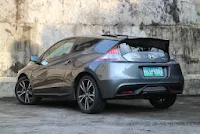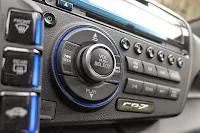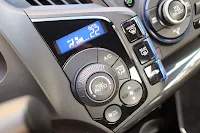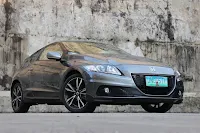 |
| Photos by Ulysses Ang |
From a passing glance, you know there’s something special with the Honda CR-Z. With a “one-motion” wedge shape, the CRZ has a low-slung hood and a broad, confident stance. The short wheelbase and large, wide mesh grille accent the CR-Z’s athletic proportions while a deeply inset line on the side adds a dynamic element. At the back, a rear diffuser mimics the floating lower lip front spoiler while functionally improving dynamics. Honda could have easily gone with the traditional sports car route with a formal three-box shape, but they went for something totally different. By all accounts, the CR-Z is a three-door hatchback down to its framed doors and sharply raked hatch. As a result, the looks are polarizing, and that’s a good start.
Honda’s interesting approach with the CR-Z continues to what you find under the hood. For starters, instead of a high-revving small displacement 4-cylinder engine or a torque-y V6 or V8 motor, the CR-Z does with a 1.5-liter i-VTEC engine coupled with Honda’s Integrated Motor Assist or IMA technology. As the name implies, the IMA is an electric motor which assists the CR-Z in acceleration. It can also act as a generator to charge the lithium-ion battery pack. All in all, the CR-Z produces a peak 135 horsepower and 171 Nm of torque (the M/T variant has slightly more bite at 136 horsepower and 190 Nm of torque).
These engine outputs don’t seem very high for such a sportily-designed car, and they’re not. But don’t blame the engine. With maximum torque available from as low as 1,750 rpm, the CR-Z can make for an engaging drive, but it’s a different world altogether with the CVT or Continuously Variable Transmission. In any mode not starting with “S”, the CR-Z performs more like a sub-compact hatchback rather than a bonafide Toyota 86/Subaru BRZ challenger. Yes, there’s ample push, but not enough to make you or your passenger hold on for dear life. And that’s a weak point right there: sports cars are supposed to provide that feeling of exhilaration; the CR-Z does not.
And since the topic of engine modes was already brought up, let’s talk about the Honda 3-Mode Drive system, one of the trademarks of the CR-Z. Designed to provide additional performance or fuel economy, the CR-Z allows the driver to freely shift from Sport, Normal, or Econ modes for different driving styles and situations. The system applies integrated control over the CR-Z’s drive-by-wire accelerator, motor assist, transmission, electric power steering, and even climate control. There’s a noticeable difference switching between modes with Sport noticeably tightening the steering and instantaneously providing throttle response while the Econ conversely makes the gas pedal feel heavier and sluggish. That said, even in Eco mode, the CR-Z is still pretty interesting to drive given the involving and quick responding steering.
On the subject of fuel economy, the CR-Z delivers a respectable 9.9 km/L in city traffic and 18.2 km/L in highway. After some 630 kilometers of mixed driving, the net is 12.4 km/L—pretty respectable figures, but it pales in comparison to a true hybrid such as the Toyota Prius or even a small displacement diesel such as the Hyundai Accent CRDi.
That said, if you had those three cars in your garage, you’ll pick the CR-Z 100 percent of the time, not because of its touted fuel economy but because of its impeccable road manners. It’s not quite the track car or canyon carver, but the CR-Z’s firm suspension and good steering are enough to provide an engaging experience behind the wheel. On the city, the CR-Z feels just as fun to drive as the Toyobaru twins and is enough to even merit thumbs up from passerby. However, once the crowded Manila streets turn into long stretches of road with left-right switchbacks, the CR-Z is betrayed by its front-wheel drive, non-independent rear suspension architecture.
On 2013 models, the CR-Z’s 3-Mode system is supplemented by the Plus-Sport system which acts like Formula One’s KERS system. It uses the charge from the battery pack to power the electric motor and give an additional boost in acceleration. Honda says it’s comparable to a 3.0-liter V6 engine, and from behind the wheel, there’s no denying the feeling of rush.
From the driver’s seat, the CR-Z successfully carries the same high-tech appearance and feels with an intuitive cockpit that’s canted towards the driver. It looks sophisticated, but in true Honda fashion, it’s very easy to use. The instrument panel illuminates with a three-dimensional blue color theme resulting in a multi-layered appearance. This instrument panel also serves as the visual representation to the 3-Mode Drive system. The small diameter steering wheel is a joy just to look at and even more so to hold; while the black sport bucket seats with red stitching lend an unmistakably sporty look to the CR-Z. There are also metallic trims scattered about: on the door pull, center console, and speaker grille to name a few all adding a classy and sophisticated touch.
The CR-Z’s hatchback design would lead you to believe that it’s relatively functional, and though the brochure says it seats four in a 2+2 layout, the rear seats are painfully small. So small that only Sized 0 models with no legs can fit in there without compromising the comfort of those sitting in front. In short, that bench is best left for shopping bags and other knick-knacks. And you’ll need it. With the rear seats up, the CR-Z does with a paltry 225 liters cubic meters of luggage space, not even enough for two large duffel bags; with the rear seats down, it grows to 393 liters. In direct comparison, the Toyobaru twins have 243 liters with the rear seats up and a whopping 1,270 liters with the rear seats down.
Sporty and efficient, the Honda CR-Z may not have the practicality, but it does come packed with features to keep the segment quite interesting. Priced at P 1,560,000 for the Modulo CVT tested, it comes equipped to sell with projector-type HID headlamps, LED park lights, front fog lamps, rain-sensing wipers, LED tail lamps, 17-inch alloy wheels (with extra sticky Michelin Pilot Sport 3 205/45R17Ws) and a dry carbon fiber under spoiler set inclusive of a ducktail-type tailgate spoiler.
Overall, the Honda CR-Z isn’t 100 percent worthy of a sports car badge, but you’ve got to drive one to truly have your interest piqued. It’s not a true driver’s car, but it’s worthy proof that Honda’s starting to get its groove back in driving excitement. With an acronym meaning “Compact Renaissance Zero”, the CR-Z represents Honda’s commitment to go back to the point of origin and take on the challenge of creating a new compact sports car without being bound by the values of traditional sports cars. Indeed, the Honda CR-Z brings a new definition to mobility by successfully balancing sportiness and economy. Now, if only it would grow a few more millimeters in the backseat, it would have been perfect.
|
2013 Honda CR-Z Modulo
|
|
| Ownership | CR-Z Modulo CVT |
| Year Introduced | 2013 |
| Vehicle Classification | Sports Car |
| The Basics | |
| Body Type | 3-door Sports Car |
| Seating | 2+2 |
| Engine / Drive | F/F |
| Under the Hood | |
| Displacement (liters) | 1.5 + Electric Motor |
| Aspiration | NA |
| Layout / # of Cylinders | Inline 4 |
| BHP @ rpm | 135 @ 6,600 |
| Nm @ rpm | 171 @ 1,000-3,000 |
| Fuel / Min. Octane | Unleaded / 93~ |
| Transmission | CVT |
| Cruise Control | Yes |
| Dimensions and Weights | |
| Length (mm) | 4,075 |
| Width (mm) | 1,740 |
| Height (mm) | 1,395 |
| Wheelbase (mm) | 2,435 |
| Curb Weight (kg) | 1,195 |
| Suspension and Tires | |
| Front Suspension | Independent, Double Wishbone |
| Rear Suspension | Torsion Beam Axle |
| Front Brakes | Vented Disc |
| Rear Brakes | Disc |
| Tires | 205/45R17 |
| Wheels | Alloy |
| Safety Features | |
| Airbags | 6 |
| Anti-Lock Brakes (ABS) | Yes |
| Traction / Stability Control | Yes |
| Parking Sensors | No |
| Exterior Features | |
| Headlights | HID |
| Fog Lamps | Front |
| Auto Lights | Yes |
| Auto Wipers | Yes |
| Interior Features | |
| Steering Wheel Adjustment | Tilt/Telescopic |
| Steering Wheel Material | Leather |
| Seating Adjustment | Manual |
| Seating Surface | Leather/Fabric |
| Folding Rear Seat | Yes |
| On-Board Computer | Yes |
| Convenience Features | |
| Power Steering | Yes |
| Power Door Locks | Yes |
| Power Windows | Yes |
| Power Mirrors | Yes |
| Climate Control | Yes |
| Audio System |
Stereo CD MP3 Aux USB |
| No. of Speakers | 6 |
| Steering Wheel Controls | Yes |

























other than the good mileage offered by CRZ, Id still pick the 86
ReplyDeleteim confused in what honda is trying to sell...a sports car or simply a subcompact hatchback...if hyundai veloster is a poser (except for the other one with turbo) this honda cr-z is worse...for its size i think it should not have rear seats...i'd still pick veloster over cr-z...best choice is to wait for 2014 mazda3 skyactiv...toyota 86, scion frs, subaru brz all the same which is not a good thing...and at 1.8+M?...nah...i'd rather save few more bucks for an audi A1 TFSI sportback..how 'bout that...more power, luxury and hey its german...
ReplyDeleteSOME ARTICLES I READ CONSUMPTION IS 15KMS/LTR IN CITY DRIVING
ReplyDelete